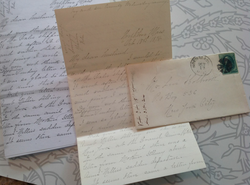 The following article is reprinted from the course listing at "Family Tree University," an online education program from the publishers of Family Tree Magazine: Especially prior to 1700, people in England used a relatively small variety of first and last names, so you'll need as many clues as possible to separate, say, your John Taylor from all the other John Taylors in England. Identifying your ancestor's place of residence and/or birth is critical. To make sure you're tracing the right person, take note of neighbors, others with the same last name in the same or neighboring towns, even patterns of first names-both in the earliest American records of your ancestor and in possible matches in England. Because British colonists made up so much of early America, the first-name traditions from back in Merry Old England often continued in the colonies. So this scheme, common especially in the 18th and 19th century, may be useful for sorting out ancestors even on this side of the pond:
In families where this pattern would lead to duplicate names-if both grandparents were named Robert, for example-the parents might skip to the next in line. In this case, the second son could be named after the father. By the 16th century, this English naming pattern was also common in Wales. Keep in mind, too, that English records routinely abbreviated many common names, such as recording William as Wm. You may also find nicknames, such as Will, Dick, Bess, Betty and Molly; as fans of Shakespeare know, Henry was often called Harry. Some names are even interchangeable in how they are used, such as Edward and Edmond or Elizabeth and Isobel. Similarly, Ann, Hannah and Nancy could all be the same person, and Margaret, Daisy and Peggy are variations of the same name. To learn more about this and other genealogy research subjects, visit familytreeuniversity.com.
0 Comments
 A stamp collector recently listed an envelope on eBay for its postal cancellation. As a genealogist, I saw it more specifically as an envelope that happened to still have a letter from 1875 still inside. As serendipity usually has it with these things, the story told by a visitor to Northborough, MA has an intriguing plot, curious characters, and an ending that could only have been written this afternoon by myself and a willing fellow mystery-solver. Mrs. Viola Holbrook, staying at the home of her Aunt Susan's husband Cyrus Gale, wrote to her own husband back home in New York City about such quaint things as slipper orders and glove sizes. She also recounted what she learned in several letters she had received over a very short time: that her Aunt Nellie's fiancé had cheated on her and called off the wedding that was to happen within the month. Nellie had fled to a hotel in NYC to escape her shame and hide her sorrow. Viola, having none of that, instructed her husband to find Nellie and console her in Viola's stead. Who was Viola Holbrook and why was she visiting a small town in MA, so far from the social buzz of Manhattan? Who was Nellie and how exactly was she related to the Holbrooks? Did Nellie ever marry…and whom? The strategy: (1) Read the letter. Many times. Make note of places, names, and possible relationships. (2) Sketch out the family trees of each identifiable person mentioned in the letter. (3) Research each person on the trees to locate correlating evidence and establish how the people are related. Tips: (1) Nicknames (such as "Nellie") aren't always used in historical documents. Search using the more formal version of common nicknames for better results. (2) Family relationships (references to "aunt" or "Mother") may be for a spouse's family as well. The bonus: Ask the question "What happened next?" to initiate another research plan. In this case, we found that the scorned bride-to-be took back her philandering fiancé to eventually live in North Carolina with their servants. Who knew a simple census enumeration could tell such a complicated story about betrayal, sorrow, forgiveness, and deep devotion? |
AuthorBeth Finch McCarthy
|

